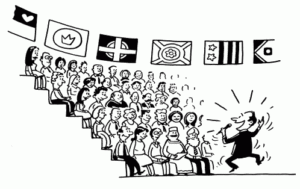
Delivering customer service training to a worldwide audience can be a minefield of potential errors, missteps and disasters. Whether you have 30 or 300, it is likely that you will face men and women, old and young, company veterans and brand-new employees, locals and foreigners, married, single or recently divorced, and every possible mix of ethnic, religious and sexual persuasion. With a group like this, you can offend without intention, insult without meaning to, and alienate without even trying.
Avoid painful mistakes when providing customer service training! Follow these twelve tips when you work with participants from around the world during customer service training or other programs and you will find yourself with an attentive, involved and harmonious learning group.
1. Don’t assume. Ask!
Don’t assume everyone in the room is just like you or like anyone else during customer service training or any other program! Acknowledge the diversity in the room. Highlight the rich range of life and business experience this group can represent.
Ask participants to share about themselves in small groups. Start with easy questions: business experience, educational background, places they have lived or worked. As conversation warms up, move to current business issues: ask their opinions on trends in the industry, entry of new competitors, products, technologies or government regulations. Then get right to the customer service training topic at hand: have participants discuss expectations of the course, problems they need to solve, solutions they intend to discover.
Finally, when groups are well lubricated with rapport, ask participants to share about their personal lives – family, hobbies, vacations and other special interests.
2. Speak very clearly and distinctly.
Your native tongue may not be the first language of all your audience members. Adjust your presentation style so everyone can easily follow the customer service training.
Years ago I spoke in Australia in front of a large international audience. Eleven countries were represented with seven different languages. Simultaneous translation was provided for non-native English speakers. Energized by the crowd, I launched into a presentation of humorous stories, anecdotes, case studies and key learning points for customer service training. Throughout the speech, I was pleased to hear the Japanese contingent laughing at all of my jokes.
Or so it seemed. After the presentation, one Japanese participant set me straight: I was speaking so quickly, the interpreter was unable to keep up. Instead of translating my customer service training presentation, he gave up and spent most of the time talking in Japanese about how funny it was to see this American fellow rushing about in a big hurry on stage! I laughed when I heard this report, but I certainly learned the lesson: With an international audience, s-l-o-w d-o-w-n, and speak very clearly.
3. Bridge the communication gap.
Some of your group may be participating in a language that is not their native tongue. If their vocabulary or pronunciation is difficult for others to understand, you can bridge the gap by clearly repeating their comments and contributions to others attending the customer service training program.
Go beyond the spoken word to encourage understanding: use graphics, charts, pictures, video, physical examples, role-playing and other non-verbal techniques to get your points across.
4. Encourage everyone to participate.
Newcomers bring fresh perspective. Old-timers have experience and wisdom. Locals understand “what’s happening here and now.” Foreigners have a “global” point of view.
Be liberal with your compliments and praise. “That’s a very good question!” let’s everyone know it’s safe to ask the next one. “Thank you for your answer!” tells the whole room it’s safe to venture a reply during customer service training.
5. Be experienced, not exceptional.
Customer service training professionals are often widely experienced and well-traveled. They can bring good value to the group, but don’t highlight the differences too much. You want respect, not distance. When connecting with an international group for customer service training, a little humility goes a long way.
6. Speak the local language.
If possible, use local language, customs and examples in your presentation. This may require some preparation on your part, but it can make a very big impact on your group during customer service training.
Toward the end of the Cold War, comedian Billy Crystal began a stand-up routine in Moscow by conducting the first five minutes entirely in Russian. But Billy Crystal doesn’t speak Russian; he had memorized his entire opening act in translation! The Russian audience howled their approval and continued laughing as he delivered the rest of his show in English.
7. Avoid phrases that do not translate well.
What is “clear as a bell” to you may be “thick as mud” in every other language. Avoid phrases that do not translate well during customer service training. “Six of one, half a dozen of the other,” “by the skin of your teeth,” “right as rain” and “chicken with your head cut off” may translate nicely in your home town, but can bring real confusion and frustration overseas. Do you “catch my drift”?
8. If in doubt, leave it out.
Exercise great caution with your comments on politics, religion, sexuality, ethnic issues and humor during customer service training. What is funny to one group may be downright offensive to another. There are plenty of things to laugh about in this world without poking fun at any one group. Make one mistake during customer service training and people could remember it forever.
9. Triple check all translations.
If your presentation, workbook and handouts are translated into another language, check the choice of words and phrases many times. Use a professional translator who is familiar with your field of work. Then check it again with actual participants in your group.
At the Service Quality Center in Singapore, we use the phrase “Never Settle” to mean “strive for continuous improvement.” But when we first took this phrase overseas, it was translated into Mandarin like this: “never agree in a negotiation.” And the phrase became “don’t sit down” in Indonesia!
10. Mix up the group to increase participation.
Sharing experiences is one of the best aspects of international customer service training. But don’t count on participants to do it by themselves. Give the process a boost by mixing the group in various ways. Suppose you have 32 participants. You can combine them at various times into smaller teams of 2, 4, 6, 8 or even 16.
Do a random split by having them “count off” with numbers around the room. Or have a bit more fun! I often divide my groups by date of birth, number of siblings, seniority with the company, first letter of their family name, length of hair, color of socks, you name it!
11. Assure talk time for all.
Some nationalities are naturally more outspoken than others. Be sure everyone gets a chance to speak up by structuring the sequence of participation during customer service training. Once everyone is in small groups, have the most senior member of the group speak first, or the most junior. Ask the women to talk first, or those who have traveled from farthest away.
Acknowledge outspoken participants, but don’t let them overwhelm the conversation during customer service training. I often do this by having small groups nominate a spokesperson, then having that person nominate someone else in the group to speak on their behalf!
12. Bring them back together at the end.
Mixing everyone up is great for sharing new ideas during customer service training. But be sure you bring everyone back together at the end to prioritize key points and generate new action steps. Have real work groups (whether by function, country, customer or project) explain the relevance of their learning to the job and state their plans for improvement and implementation.
Whether you have customer service training to bring, a session to present or an important meeting to facilitate, these time-tested techniques will help bring out the best in your participants – and you!
—————————————————————————————————————————–
You may use this article in your free newsletter, website or publication providing you include this complete statement (below) with active links to the websites:
Copyright, Ron Kaufman. Used with permission. Ron Kaufman is the world’s leading educator and motivator for upgrading customer service and uplifting service culture. He is author of the bestselling “Uplifting Service” books and founder of Uplifting Service. To enjoy more customer service training and service culture articles, visit www.RonKaufman.com.
For commercial use of this article in a paid newsletter, publication, or training program, please contact us.



